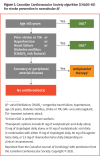Approach to atrial fibrillation: Essentials for primary care
- PMID: 37072207
- PMCID: PMC10112727
- DOI: 10.46747/cfp.6904245
Approach to atrial fibrillation: Essentials for primary care
Abstract
Objective: To support family physicians in preventing atrial fibrillation (AF) in patients at risk and in identifying and managing those with established AF; and to summarize key recommendations for ideal screening and care of patients.
Sources of information: The 2020 Canadian Cardiovascular Society and Canadian Heart Rhythm Society comprehensive guidelines for the management of AF, based on current evidence and clinical experience related to AF.
Main message: Atrial fibrillation, which is estimated to affect at least 500,000 Canadians, is associated with high risks of stroke, heart failure, and death. Primary care clinicians occupy a central role in the management of this chronic condition, focusing on the challenges of preventing AF and identifying, diagnosing, treating, and following patients with AF. Evidence-based guidelines that provide optimal management strategies have been published by the Canadian Cardiovascular Society and Canadian Heart Rhythm Society to assist in these tasks. Messages critical to primary care are offered to support effective knowledge translation.
Conclusion: Most patients with AF can be managed effectively in primary care. Family physicians not only play an important role in ensuring patients with AF receive timely diagnoses, but they are also key to providing initial and ongoing care, especially in patients with comorbid conditions.
Objectif: Aider les médecins de famille à prévenir la fibrillation auriculaire (FA) chez les patients à risque, et à identifier et prendre en charge les personnes présentant une FA établie; résumer les principales recommandations pour un dépistage et des soins idéaux pour les patients.
Source de l’information: Les lignes directrices exhaustives publiées en 2020 par la Société canadienne de cardiologie et la Société canadienne de rythmologie pour la prise en charge de la FA. Elles reposent sur les données et l’expérience clinique actuelles relatives à cette affection.
Message principal: La fibrillation auriculaire, qui, selon les estimations, touche au moins 500 000 Canadiens, est associée à des risques élevés d’accident vasculaire cérébral, d’insuffisance cardiaque et de décès. Les cliniciens de première ligne jouent un rôle central dans la prise en charge de cette affection chronique en mettant l’accent sur les défis de la prévention de la FA, ainsi que du repérage, de la pose du diagnostic, du traitement et du suivi des patients atteints de la FA. Pour les aider dans ces tâches, la Société canadienne de cardiologie et la Société canadienne de rythmologie ont publié des lignes directrices fondées sur des données probantes qui proposent des stratégies de prise en charge optimales. Des messages essentiels pour les soins primaires sont communiqués de manière à soutenir une application des connaissances efficace.
Conclusion: La plupart des patients atteints de FA peuvent être pris en charge efficacement au niveau des soins primaires. Non seulement les médecins de famille jouent-ils un rôle important en voyant à ce que les patients qui souffrent de FA soient diagnostiqués à temps; ils sont également essentiels à la prestation des soins initiaux et continus, surtout chez les personnes présentant des troubles comorbides.
Copyright © 2023 the College of Family Physicians of Canada.
Figures





References
-
- Andrade JG, Aguilar M, Atzema C, Bell A, Cairns JA, Cheung CC, et al. . The 2020 Canadian Cardiovascular Society/Canadian Heart Rhythm Society comprehensive guidelines for the management of atrial fibrillation. Can J Cardiol 2020;36(12):1847-948. Epub 2020 Oct 22. - PubMed
-
- Hindricks G, Potpara T, Dagres N, Arbelo E, Bax JJ, Blomström-Lundqvist C, et al. . 2020 ESC guidelines for the diagnosis and management of atrial fibrillation developed in collaboration with the European Association for Cardio-Thoracic Surgery (EACTS): the task force for the diagnosis and management of atrial fibrillation of the European Society of Cardiology (ESC) developed with the special contribution of the European Heart Rhythm Association (EHRA) of the ESC. Eur Heart J 2021;42(5):373-498. Errata in: Eur Heart J 2021;42(5):507, Eur Heart J 2021;42(5):546-7, Eur Heart J 2021;42(40):4194. - PubMed
-
- January CT, Wann LS, Calkins H, Chen LY, Cigarroa JE, Cleveland JC Jr, et al. . 2019 AHA/ACC/HRS focused update of the 2014 AHA/ACC/HRS guideline for the management of patients with atrial fibrillation: a report of the American College of Cardiology/American Heart Association Task Force on Clinical Practice Guidelines and the Heart Rhythm Society in collaboration with the Society of Thoracic Surgeons. Circulation 2019;140(2):e125-51. Epub 2019 Jan 28. Erratum in: Circulation 2019;140(6):e285. - PubMed
Publication types
MeSH terms
Substances
LinkOut - more resources
Full Text Sources
Medical
Research Materials
